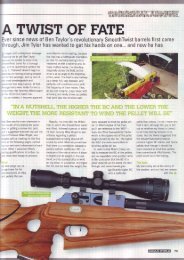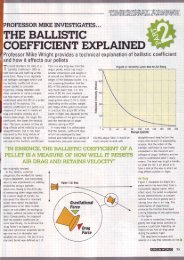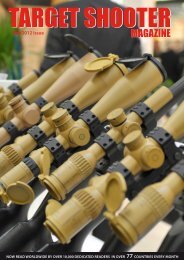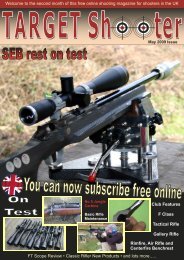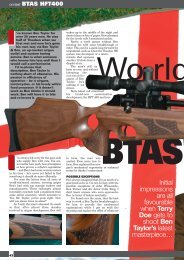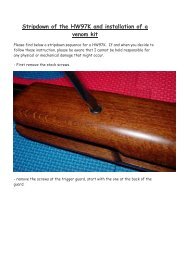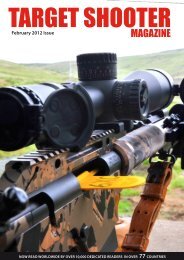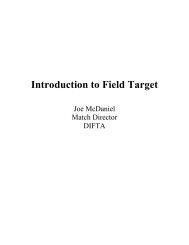Target Shooter 1
Target Shooter 1
Target Shooter 1
Create successful ePaper yourself
Turn your PDF publications into a flip-book with our unique Google optimized e-Paper software.
eplicated on the rifle range.<br />
The moral is that a slight BC<br />
advantage does not in itself<br />
guarantee a superior score! Just<br />
look at the simulated ‘match<br />
score’ spread for any given<br />
bullet – up to 17 points difference<br />
(out of a possible 200), yet the<br />
difference between the best and<br />
worst ballistic performers is only<br />
4 points over 100 ‘matches’ when<br />
scores are averaged. The take<br />
away from this exercise is that<br />
although the higher BC bullets do<br />
stand to produce slightly higher<br />
scores on average, they don’t<br />
radically alter the limitations<br />
intrinsic to TR and Fullbore<br />
shooting – 155gn 0.308” bullets at<br />
around 3,000 fps MV.<br />
Let’s look at performance from<br />
a different but complementary<br />
angle. If the wind uncertainty is<br />
modelled as +/- 1.5 mph<br />
instead of +/- 2.0 mph, the<br />
average score for every bullet<br />
goes up four points. In other<br />
words, if the shooter or coach<br />
can refine his or her ability to read<br />
the wind by only 0.5 mph that<br />
makes as much difference to the<br />
average score as switching from<br />
the lowest BC bullet to the highest.<br />
Figure 5 slightly inferior bullet<br />
because of the<br />
statistical nature of<br />
error. Also note that average scores drop from<br />
192 to 191, then 190 for the best performers<br />
in descending order as you’d expect, but then<br />
apparently perversely go back up to 191 for the<br />
PMP bullet, before falling again to 188 for the<br />
two ‘poorest’ designs. This is another symptom<br />
of the statistical nature of the uncertainties we<br />
encounter in target shooting, and is likely to be<br />
F/TR Class<br />
The above analysis was geared<br />
specifically to the US NRA LR<br />
prone target with a 10” X-ring,<br />
20” 10 ring, etc, but the F-class<br />
target has smaller inner rings.<br />
It’s obvious that their reduced<br />
size increases sensitivity to small<br />
errors. For example, a shot that’s<br />
a solid 10 on the prone target may be a 9 on the<br />
F-class target. So the question is; how much<br />
more sensitive is the F-class target to a difference<br />
in ballistic performance compared to the prone<br />
target? Common sense suggests that<br />
you should be able to resolve a bigger<br />
advantage in score for a given ballistic performance<br />
advantage, but how much? Again, I’ll turn to<br />
modelling (Figure 5). For this simulation, we’ll<br />
consider the shooter/coach to have the same<br />
<strong>Target</strong> <strong>Shooter</strong> 63



